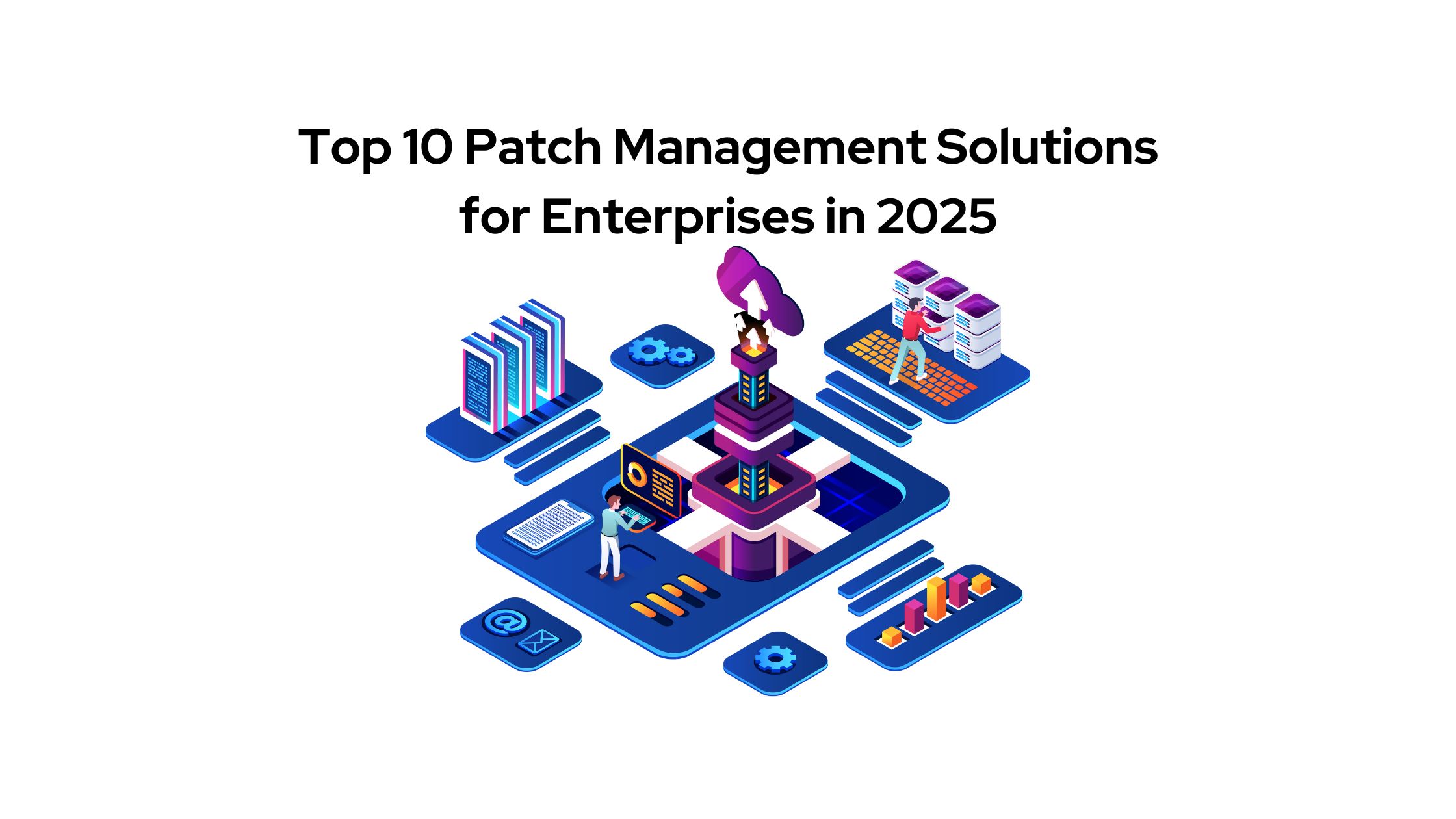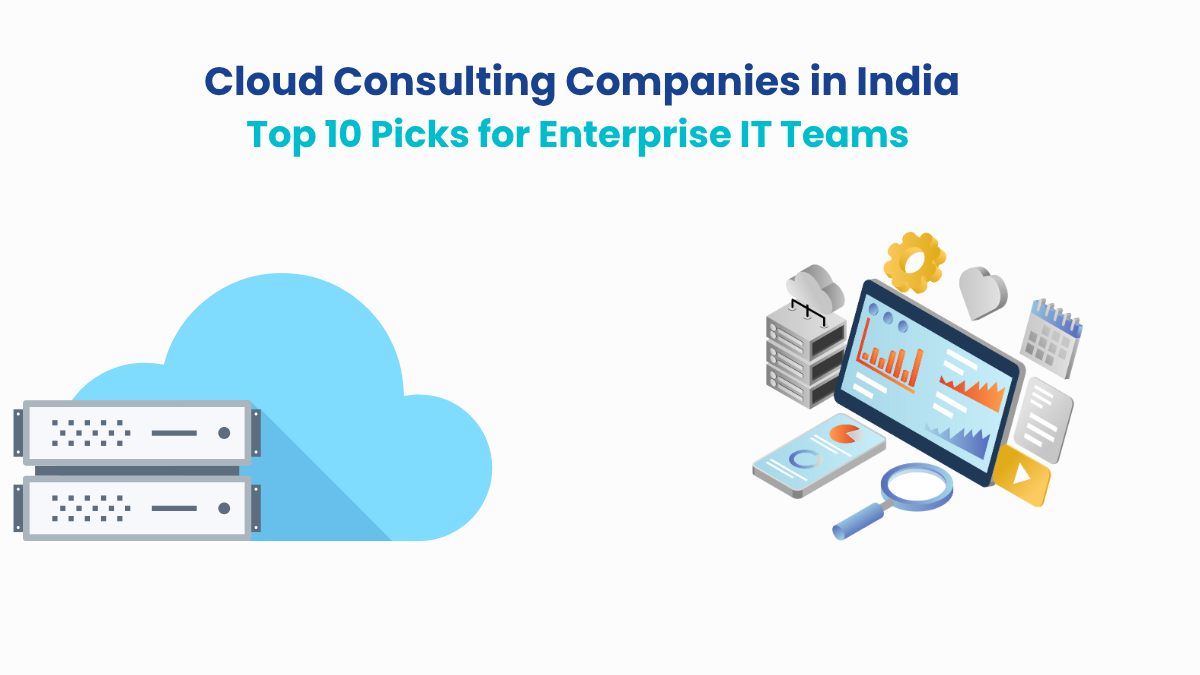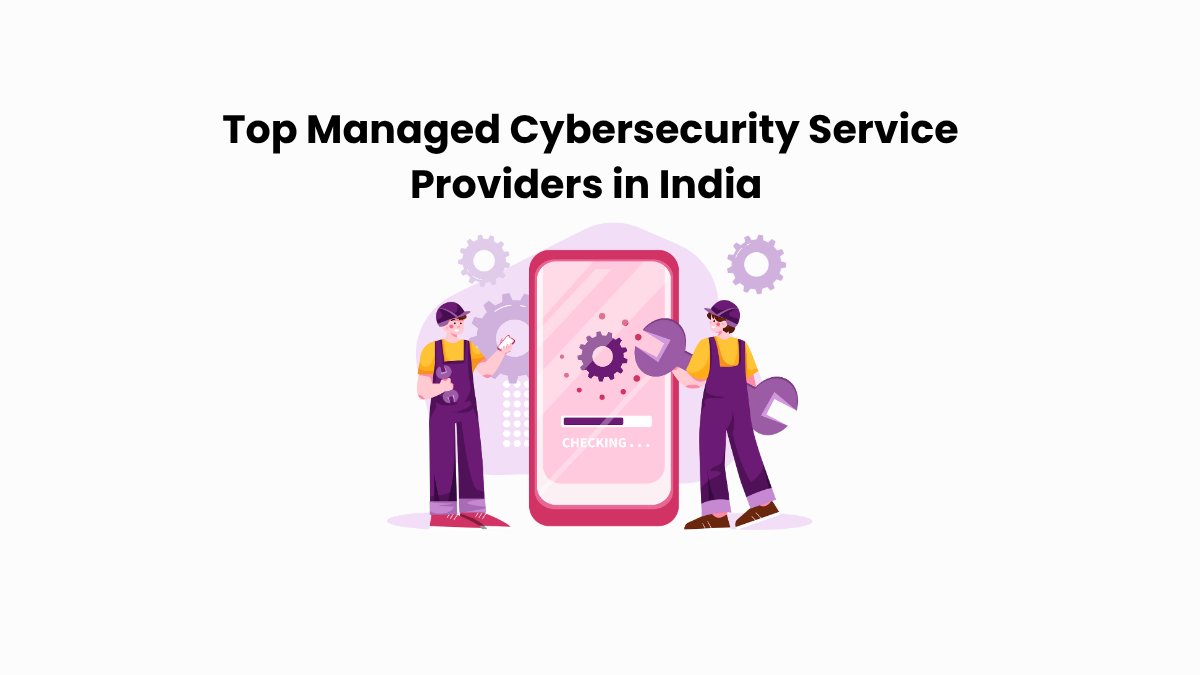Patch management solutions are no longer a nice-to-have. In 2024, 32% of ransomware attacks began with an exploited, unpatched vulnerability. Not only that, but those attacks led to 4X higher recovery costs and slower recovery times.
For enterprise security leaders, the challenge isn’t patching. It’s patching at scale, across legacy infrastructure, hybrid devices, and critical apps. All without breaking workflows or exposing new risks.
And yet, not every patch management tool is built for that level of complexity.
In this article, we break down the 10 best patch management solutions for enterprises. These solutions are ranked by automation capabilities, third-party app support, compliance readiness, and peer reviews.
Whether you’re handling 10,000 endpoints or locking down a hybrid cloud, this guide will help you choose a solution built for real-world enterprise needs.
Let’s dive in.
What Makes a Patch Management Solution Truly Enterprise-Grade?
Not all patch management tools are built for the scale, speed, and complexity that modern enterprises demand. While basic solutions can handle routine updates, enterprise IT environments require more, from real-time visibility and cross-platform coverage to airtight compliance and third-party integrations.
Here are the eight must-have features that define a truly enterprise-ready patch management solution:
1. Cross-Platform Coverage
Enterprises operate in heterogeneous environments that span Windows, Linux, macOS, mobile devices, and third-party applications. A patch management solution must support all of these, not just for visibility, but to enforce consistent security policies and reduce attack surface across every device. Anything less leaves critical gaps.
2. Automated Deployment with Safe Rollback
Manual patching at an enterprise scale is a recipe for delays and inconsistencies. The right solution should offer automated scheduling, policy-based rollouts, and phased testing with the ability to roll back patches safely in case of failure. This balance ensures both agility and operational stability.
3. Vulnerability-Based Prioritization
With hundreds of patches released monthly, enterprises can’t treat all updates equally. Leading solutions align patching with threat intelligence, prioritizing updates based on CVSS scores, known exploits, and CISA KEV alerts. This ensures that the most dangerous vulnerabilities are patched first, improving risk posture with precision.
4. Scalability to Tens of Thousands of Endpoints
A true enterprise-grade platform must scale effortlessly across thousands — or even hundreds of thousands — of endpoints, globally distributed and often offline or remote. Scalability isn’t just about infrastructure. It’s about maintaining performance, visibility, and control without introducing lag, blind spots, or patching delays.
5. Compliance and Audit-Ready Reporting
Regulatory requirements like HIPAA, PCI-DSS, ISO 27001, and NIS2 mandate detailed proof of patching activity. Enterprise tools must generate audit-ready reports, highlight unpatched systems, and support role-based access controls. This makes it easier for IT and compliance teams to demonstrate adherence and pass audits.
6. Real-Time Patch Health Monitoring
Enterprises can’t afford to wait for monthly reports to know what went wrong. They need live dashboards showing which devices are missing critical patches, which deployments failed, and how coverage looks across departments and geographies. Real-time monitoring is key to fast remediation and executive visibility.
7. Integration with EDR, SIEM, and SOAR Platforms
Patch management doesn’t operate in a vacuum. It must integrate seamlessly with your security stack from endpoint detection (EDR) to threat analytics (SIEM) and response automation (SOAR). These integrations allow patching activity to be part of your broader incident response and threat mitigation workflow.
8. Support for Remote and Hybrid Workforces
With hybrid work now the norm, patch management must extend beyond the corporate network. Enterprise tools should be cloud-native or VPN-independent, capable of patching off-network devices securely and reliably. Anything less puts remote employees and your data at risk.
Even with these capabilities in mind, many enterprises still overlook critical details when choosing a patch management solution. For instance, whether it integrates well with their security stack, supports legacy systems, or scales across remote endpoints without friction.
That’s why it’s not just about features. It’s about fit.
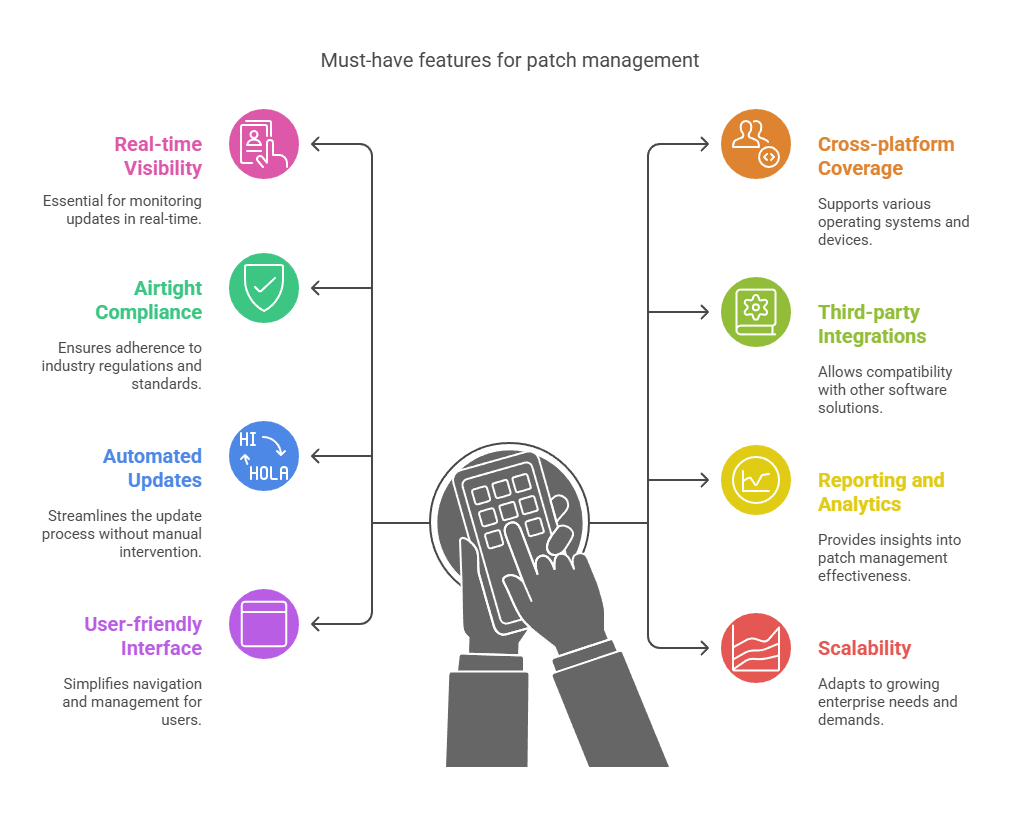
Now, let’s take a closer look at the top 10 patch management solutions for enterprises in 2025. These are evaluated for automation, visibility, compliance readiness, and real-world performance across complex environments.
#1. Microsoft Intune + Windows Autopatch
Microsoft Intune paired with Windows Autopatch offers native, policy-driven patch automation across enterprise Windows environments. It’s fully integrated with Azure AD and Microsoft Defender, enabling compliance enforcement, zero-trust controls, and conditional access policies alongside patching.
Windows Autopatch automates update delivery for Windows 10/11, Microsoft 365 apps, Edge, and Teams, significantly reducing manual workload. It uses deployment rings to test updates in waves and can automatically roll back faulty patches, all while minimizing user disruption.
It’s important to note that Microsoft Intune provides endpoint and policy management, while Windows Autopatch handles the actual patch automation for Microsoft software. Together, they provide a streamlined patching workflow. But Autopatch only covers Microsoft products. Organizations managing non-Windows OS or third-party apps may need additional tooling.
- Best For: Organizations deeply embedded in the Microsoft ecosystem seeking streamlined device and update management.
- Strength: Seamless integration with existing Microsoft services enhances operational efficiency.
- Differentiator: Combines device management and automated patching within a unified platform.
- Deployment Fit: Ideal for enterprises utilizing Microsoft 365 and Azure services.
- Use Case Tags: Windows device management, automated patch deployment, integrated security management.
#2. Automox
Automox is a cloud-native patch management platform purpose-built for cross-platform automation. It supports Windows, macOS, and Linux, giving IT teams centralized control over diverse environments without relying on on-premises infrastructure. Its cloud-native agent allows patching from anywhere. This is ideal for remote and hybrid workforces.
One of Automox’s key strengths is its support for over 500 third-party applications. Combined with customizable automation policies, this drastically reduces manual intervention and accelerates response to critical vulnerabilities. Enterprises can enforce patch timelines, monitor real-time compliance, and eliminate lag in update cycles, all from a single dashboard.
While it doesn’t currently offer patch rollback, its simplicity, fast deployment, and OS breadth make it one of the most agile patching platforms for modern IT teams.

Source – Automox
- Best For: Organizations seeking a unified patch management solution for diverse operating systems and extensive third-party application support.
- Strength: Comprehensive automation and broad OS compatibility streamline patch management processes.
- Differentiator: Cloud-native architecture enables remote patching without the need for on-premises infrastructure.
- Deployment Fit: Ideal for cloud-first environments and organizations with a distributed workforce.
- Use Case Tags: Cross-platform patching, third-party application updates, remote endpoint management.
What Users Think?
Users have highlighted several positive aspects of Automox:
- Ease of Use: The platform is praised for its user-friendly interface and straightforward implementation process.
- Cross-Platform Support: The ability to manage multiple operating systems from a single console is a significant advantage.
- Automation Capabilities: Automox’s automation features have been commended for reducing manual intervention and improving efficiency.
While the platform offers robust functionality, some users have noted areas for improvement:
- Patch Rollback Feature: The absence of a patch rollback feature has been mentioned.
- Performance with Large Deployments: Some users have reported performance concerns when managing a large number of devices simultaneously. A user mentioned, “The only downside is that Automox does not support older, obsolete operating systems. It would be great to have compatibility for legacy systems, as upgrading all OS versions isn’t always possible right away.”
Overall, Automox is recognized for its comprehensive automation capabilities, cross-platform support, and user-friendly interface, making it a valuable tool for organizations aiming to enhance their patch management processes.
#3. Ivanti Neurons for Patch Management
Ivanti Neurons for Patch Management is a cloud-native solution designed to automate the discovery, assessment, and remediation of vulnerabilities across diverse IT environments. It supports a wide range of operating systems, including Windows, macOS, and Linux, as well as numerous third-party applications, providing comprehensive coverage for enterprise assets.
A standout feature of Ivanti Neurons is its risk-based patching approach. Utilizing Ivanti’s Vulnerability Risk Rating (VRR), the platform prioritizes patches based on active risk exposure, patch reliability, and device compliance.
This ensures that critical vulnerabilities are addressed promptly, enhancing the organization’s security posture. Additionally, the platform offers extensive automation capabilities, streamlining patch deployment processes and reducing the manual workload on IT teams.
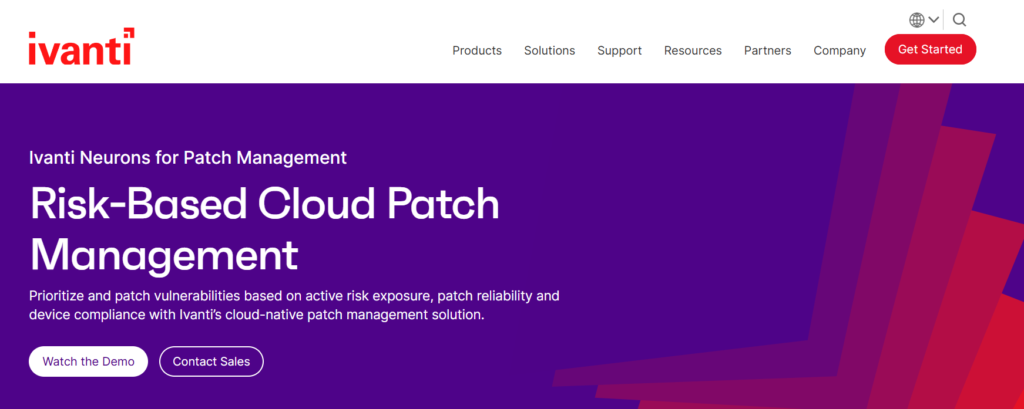
Source – Ivanti
- Best For: Enterprises seeking a unified, risk-based patch management solution with extensive automation capabilities.
- Strength: Comprehensive support for multiple operating systems and third-party applications, coupled with intelligent risk prioritization.
- Differentiator: Integration with Ivanti’s Neurons platform enables proactive threat prevention and faster response times.
- Deployment Fit: Ideal for organizations transitioning to cloud-based patch management without the need for a complete overhaul of existing systems.
- Use Case Tags: Risk-based patching, automated vulnerability remediation, cross-platform support.
What Users Think?
Users have highlighted several aspects of Ivanti Neurons for Patch Management:
- Advanced Automation and Comprehensive Coverage: The platform’s automation capabilities and broad patch coverage across heterogeneous environments are well-regarded.
- Integration with Ivanti Neurons Portfolio: The seamless integration with other Ivanti products enhances overall IT management efficiency.
While the platform offers robust functionality, some users have noted areas for improvement:
- User Interface Complexity: Some users have reported concerns about the complexity of the user interface and the learning curve associated with mastering all of its features. Additionally, occasional issues with software stability and performance have been mentioned, though these may vary depending on individual configurations and environments.
Overall, Ivanti Neurons for Patch Management is recognized for its comprehensive automation capabilities, risk-based prioritization, and integration within the Ivanti ecosystem. This makes it a valuable tool for organizations aiming to enhance their patch management processes.
#4. ManageEngine Patch Manager Plus
ManageEngine Patch Manager Plus is a comprehensive patch management solution designed to automate the deployment of patches across diverse IT environments. It supports a wide range of operating systems, including Windows, macOS, and Linux, as well as numerous third-party applications, providing organizations with a unified platform for maintaining system security and compliance.
A notable feature of Patch Manager Plus is its automated patch deployment. The platform scans systems for missing patches, tests them for stability, and deploys them automatically, reducing the manual workload on IT teams and ensuring timely remediation of vulnerabilities. Additionally, it offers customizable deployment policies, allowing organizations to tailor patching schedules and approvals to their specific operational requirements.

Source – ManageEngine
- Best For: Organizations seeking an all-in-one patch management solution with extensive automation capabilities and support for multiple operating systems and applications.
- Strength: Automated patch scanning, testing, and deployment streamline the patch management process, enhancing efficiency and reducing the risk of human error.
- Differentiator: Comprehensive support for third-party applications ensures that both operating systems and various software applications remain up-to-date and secure.
- Deployment Fit: Suitable for enterprises of all sizes, particularly those with heterogeneous IT environments requiring centralized patch management.
- Use Case Tags: Automated patch deployment, cross-platform support, third-party application patching, compliance management.
What Users Think?
Users have highlighted several aspects of ManageEngine Patch Manager Plus, including:
- Centralized Patch Management: The platform’s ability to manage patches for various operating systems and applications from a single console is highly valued.
- Remote Control Capabilities: The remote troubleshooting features are appreciated for their convenience.
While the platform offers robust functionality, some users have noted areas for improvement:
- Management of Non-Windows Devices: Managing macOS and Linux devices can require additional effort.
- Learning Curve: Advanced configurations may present a steeper learning curve.
Overall, ManageEngine Patch Manager Plus is recognized for its comprehensive automation capabilities, centralized management, and support for a wide range of operating systems and applications. This makes it a valuable tool for organizations aiming to enhance their patch management processes.
#5. CrowdStrike Falcon Spotlight
CrowdStrike Falcon Spotlight is a vulnerability management solution that provides organizations with real-time, scanless assessments of endpoint vulnerabilities. Integrated within the CrowdStrike Falcon platform, it leverages a single lightweight agent to deliver continuous visibility into security exposures without the need for traditional scanning methods.
A notable feature of Falcon Spotlight is its AI-powered predictive prioritization. Utilizing CrowdStrike’s ExPRT.AI model, it automatically prioritizes vulnerabilities based on real-time threat intelligence and adversary profiles, enabling security teams to focus on the most critical risks. Additionally, Falcon Spotlight offers seamless integration with other CrowdStrike modules, providing a unified approach to vulnerability management and threat detection.
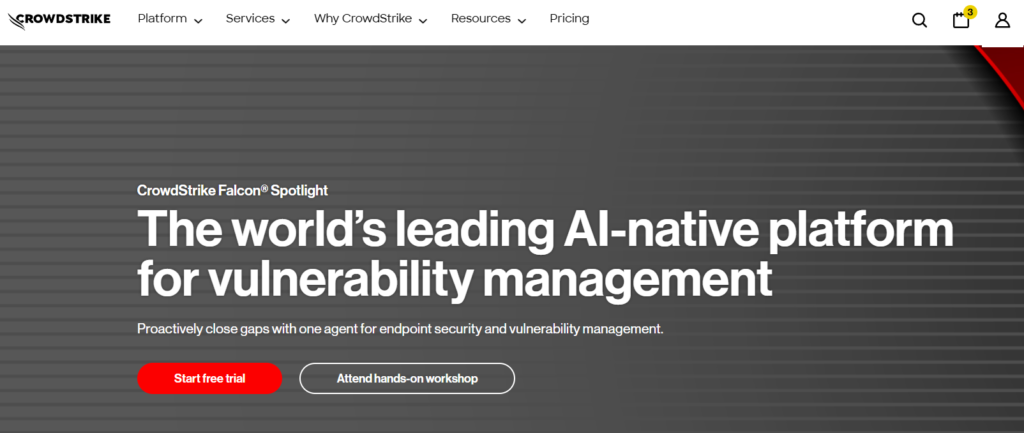
Source – Crowdstrike
- Best For: Organizations seeking real-time, scanless vulnerability assessments integrated within a comprehensive endpoint protection platform.
- Strength: Continuous, real-time visibility into endpoint vulnerabilities without the need for traditional scanning, reducing system impact and administrative overhead.
- Differentiator: AI-driven risk prioritization through ExPRT.AI, enhancing the efficiency of vulnerability remediation efforts.
- Deployment Fit: Ideal for enterprises looking to integrate vulnerability management with endpoint protection in a cloud-native architecture.
- Use Case Tags: Real-time vulnerability assessment, AI-driven risk prioritization, integrated endpoint protection.
What Users Think?
Users have highlighted several aspects of CrowdStrike Falcon Spotlight:
Ease of Use: Users appreciate the platform’s user-friendly interface and the ability to generate client reports efficiently.
Asset Management: The solution’s capability to manage both managed and unmanaged assets within the organizational network is valued.
System Insights: Falcon Spotlight provides detailed insights into endpoint devices, including information on installed applications and system resources.
While the platform offers robust functionality, some users have noted areas for improvement:
- False Positives: There have been instances of false positives, particularly concerning unmanaged assets.
Overall, CrowdStrike Falcon Spotlight is recognized for its real-time vulnerability assessment capabilities, AI-driven risk prioritization, and integration within the CrowdStrike Falcon platform. This makes it a valuable tool for organizations aiming to enhance their vulnerability management processes.
#6. BigFix HCL
HCL BigFix is a comprehensive endpoint management platform designed to automate the discovery, management, and remediation of endpoints across various environments. This includes on-premise, cloud, and virtual infrastructures. Moreover, it supports nearly 100 different operating systems, providing organizations with extensive coverage for their diverse IT assets.
A standout feature of HCL BigFix is its real-time visibility and control. The platform’s lightweight agent continuously monitors endpoints, enabling immediate detection and remediation of vulnerabilities.
This approach ensures that patches and updates are applied promptly, reducing the window of exposure to potential threats. Additionally, HCL BigFix offers robust automation capabilities, streamlining tasks such as patch deployment, software distribution, and compliance reporting.

Source – HCL Bigfix
- Best For: Organizations seeking a unified endpoint management solution with extensive automation and real-time remediation capabilities.
- Strength: Comprehensive support for a wide range of operating systems and applications, coupled with real-time monitoring and rapid vulnerability remediation.
- Differentiator: The platform’s ability to provide continuous compliance and speedy vulnerability remediation across diverse environments sets it apart from competitors.
- Deployment Fit: Ideal for enterprises with complex, heterogeneous IT environments requiring centralized management and swift response to security threats.
- Use Case Tags: Real-time endpoint management, automated patch deployment, compliance enforcement, vulnerability remediation.
What Users Think?
Users have highlighted several aspects of HCL BigFix, including:
- Scalability and Real-Time Visibility: Users appreciate the platform’s scalability and its ability to provide real-time insights into endpoint status.
- Comprehensive Endpoint Management: The solution’s extensive capabilities in managing various endpoints and ensuring security compliance are well-regarded.
While the platform offers robust functionality, some users have noted areas for improvement:
- Integration Challenges: Integrating BigFix with other third-party systems can be complex.
- Learning Curve: Due to its extensive feature set, new users may experience a learning curve.
Overall, HCL BigFix is recognized for its robust endpoint management capabilities, real-time remediation features, and scalability. This makes it a valuable tool for organizations aiming to enhance their security posture and operational efficiency.
#7. Syxsense Secure
Syxsense Secure is a cloud-native platform that unifies patch management, vulnerability scanning, and endpoint security into a single, automated system. It supports Windows, macOS, and Linux endpoints, making it a versatile choice for enterprises managing hybrid, remote, or distributed environments.
In September 2024, Syxsense was acquired by Absolute Security, a move that integrated Syxsense’s automation strengths into Absolute’s next-generation cyber-resilience platform. This adds greater reach, remote patchability, and zero-trust readiness to Syxsense’s already robust offering. This is great for organizations looking to remediate vulnerabilities without relying on VPN access.
Its standout feature is the Syxsense Cortex™ automation engine, which lets teams build remediation workflows through a drag-and-drop interface. The platform continuously scans for vulnerabilities and automates responses, making it ideal for enterprises that want to reduce mean time to patch and improve compliance.
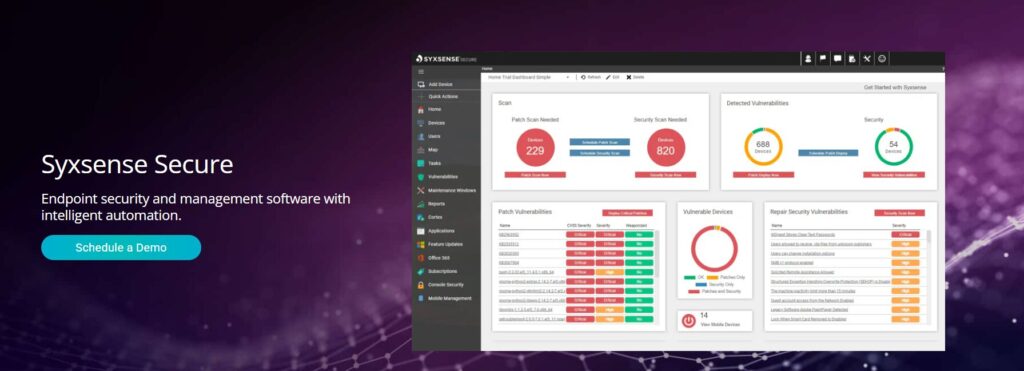
Source – Syxsense
- Best For: Enterprises with distributed endpoints and hybrid teams.
- Strength: Integrated patching, EDR, and vulnerability scanning with automated workflows.
- Differentiator: Backed by Absolute Security, offering deeper resilience and cross-platform reach.
- Deployment Fit: Best suited for remote-first, cloud-native environments.
- Use Case Tags: Patch automation, vulnerability remediation, zero-trust readiness, remote compliance.
What Users Think?
After Syxsense was acquired by Absolute Security in September 2024, the company announced major improvements in automation and vulnerability remediation. However, as of April 2025, there are no verified user reviews specifically reflecting the platform’s post-acquisition performance.
#8. Omnissa Workspace ONE UEM (formerly VMware)
Omnissa Workspace ONE UEM is a unified endpoint management platform that allows enterprises to manage Windows, macOS, iOS, Android, and Chrome OS devices from a single cloud-based console. Previously known as VMware Workspace ONE, the platform became part of Omnissa following Broadcom’s acquisition of VMware in late 2023.
Workspace ONE UEM provides enterprise-grade automated patching, app management, and compliance enforcement across desktops, mobile, and rugged devices. Admins can configure and monitor OS updates through flexible, policy-based workflows. It is ideal for managing large, distributed fleets with diverse operating systems.
Its tight integration with VMware Horizon and other virtualization solutions also makes it popular among VDI-heavy and regulated industries. With continued development under the Omnissa brand, Workspace ONE remains a top choice for enterprises looking to centralize device and patch management at scale.
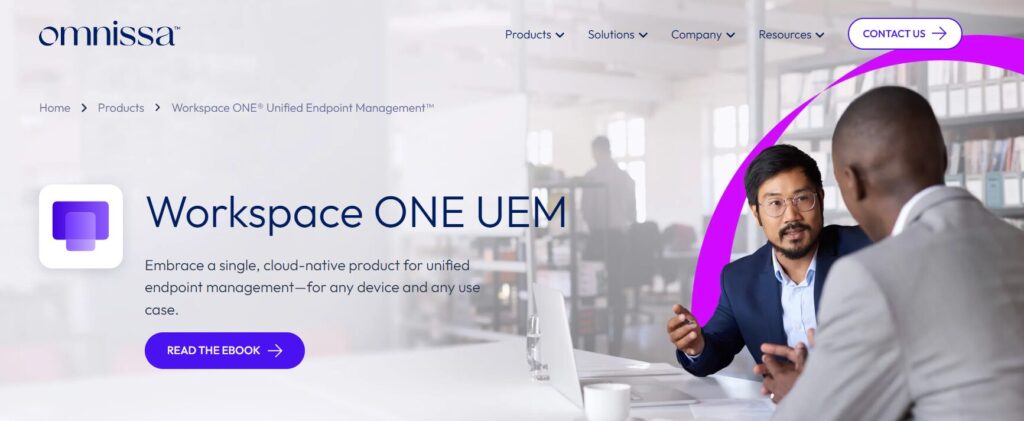
Source – Omnissa
- Best For: Enterprises with hybrid device environments and strict compliance needs.
- Strength: Broad platform support and deep integration with virtualization infrastructure.
- Differentiator: Now backed by Omnissa (Broadcom), with a renewed focus on unified device lifecycle management.
- Deployment Fit: Best suited for global IT teams managing laptops, mobiles, and virtual endpoints.
- Use Case Tags: Unified endpoint management, cross-platform patching, compliance automation.
What Users Think?
Users have shared varied experiences with Omnissa Workspace ONE UEM:
- Comprehensive Device Management: The platform is recognized for its extensive capabilities in managing a diverse range of devices and operating systems.
- Security and Compliance: Users appreciate the platform’s robust security features, aiding organizations in maintaining compliance across devices.
However, some users have identified areas for improvement:
- Complex Integration and User Interface: Integrating Workspace ONE UEM with other solutions can be complex, and the user interface may not be intuitive for all users.
- Learning Curve: New users may experience a learning curve due to the platform’s extensive feature set.
Overall, Omnissa Workspace ONE UEM is valued for its comprehensive device management and security features. However, organizations should be prepared to invest time in integration and user training to fully leverage its capabilities.
#9. Qualys Patch Management
Qualys Patch Management is a cloud-based solution designed to streamline and accelerate the remediation of vulnerabilities across diverse IT assets. Integrated within the Qualys Cloud Platform, it offers organizations real-time visibility and control over their patching processes, ensuring that systems remain up-to-date and secure.
A notable feature of Qualys Patch Management is its automated patch deployment capability. Administrators can efficiently schedule patch deployment jobs tailored to specific asset types or swiftly deploy emergency patches as needed. The platform supports a wide range of operating systems, including Windows, Linux, and macOS, as well as numerous third-party applications.
Additionally, Qualys Patch Management integrates with the Qualys Vulnerability Management, Detection, and Response module, enabling organizations to prioritize vulnerabilities based on risk and business impact. This integration facilitates a comprehensive approach to vulnerability remediation, combining detection, assessment, and patching within a unified workflow.
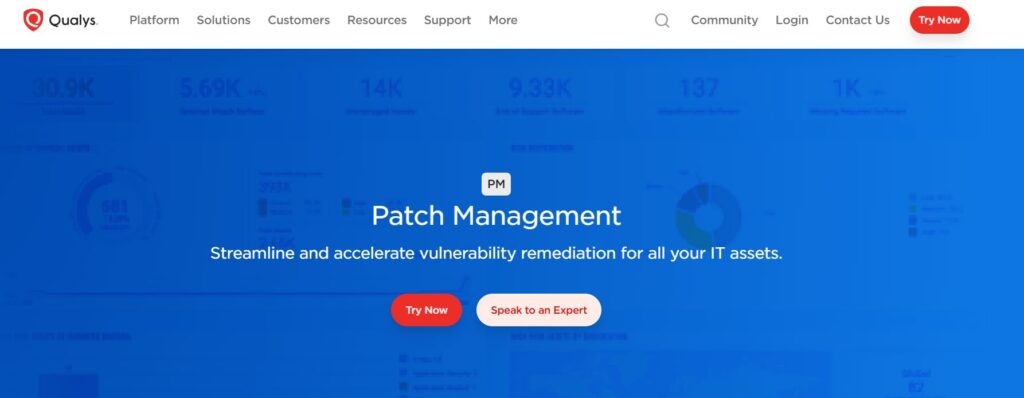
Source – Qualys
- Best For: Organizations seeking a unified solution for vulnerability detection and patch management across various operating systems and applications.
- Strength: Automated patch deployment with real-time visibility and control, supporting a broad spectrum of OS and third-party applications.
- Differentiator: Seamless integration with Qualys VMDR for a holistic approach to vulnerability management and remediation.
- Deployment Fit: Suitable for enterprises of all sizes, particularly those with hybrid infrastructures comprising on-premises, cloud, and remote endpoints.
- Use Case Tags: Automated patch management, vulnerability remediation, compliance enforcement, cross-platform support.
What Users Think?
Users have shared their experiences with Qualys Patch Management:
- Comprehensive Patching Solution: Users appreciate the platform’s ability to automate patch deployment across a wide range of assets, reducing manual intervention.
- Enhanced Vulnerability Remediation: The integration with Qualys VMDR has been highlighted as a significant advantage, enabling efficient detection and remediation of vulnerabilities.
While the platform offers robust functionality, some users have identified areas for improvement:
- User Interface and Reporting: Some users have expressed a desire for a more intuitive interface and enhanced reporting capabilities.
- Patch Detection Speed: There have been mentions of delays in patch detection, with patches being released 24 hours after QIDs are published. Improving detection speed has been suggested to enhance the platform’s efficiency.
Overall, Qualys Patch Management is recognized for its robust patching capabilities and integration with vulnerability management. It offers organizations a comprehensive solution for maintaining system security and compliance.
#10. Tanium Patch
Tanium Patch is a comprehensive patch management solution designed to provide real-time visibility and control over endpoints across an organization’s IT infrastructure. Leveraging Tanium’s unique linear chain architecture, it enables IT operations teams to efficiently deploy patches at speed and scale, ensuring systems remain up-to-date and secure.
A standout feature of Tanium Patch is its real-time data capabilities, allowing organizations to swiftly identify and remediate vulnerabilities, thereby reducing risk exposure and enhancing business resilience. The platform supports patching for various operating systems, including Windows and Linux, and offers customizable patch scheduling and workflows to suit diverse enterprise needs.
Additionally, Tanium Patch integrates seamlessly with other modules within the Tanium platform, such as Tanium Comply, facilitating a holistic approach to vulnerability and compliance management.
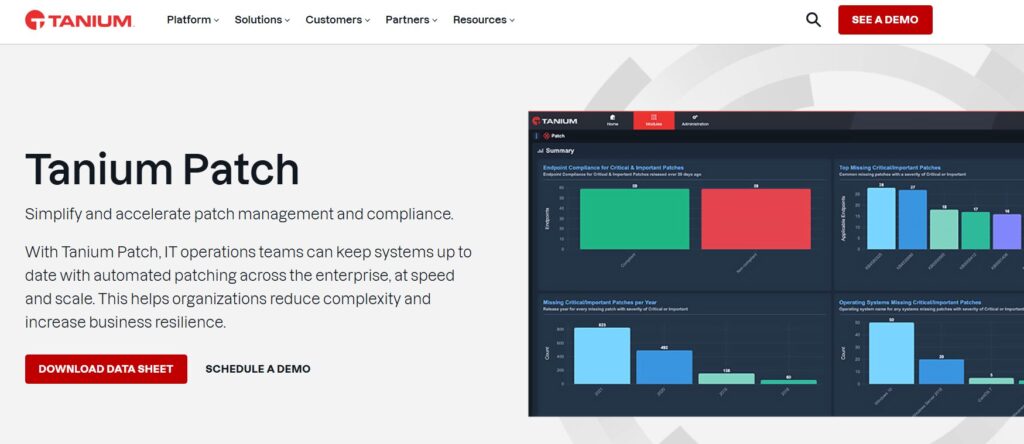
Source – Tanium
- Best For: Large enterprises seeking a scalable and efficient patch management solution with real-time endpoint visibility.
- Strength: Real-time patch deployment capabilities with comprehensive endpoint visibility and control.
- Differentiator: Unique linear chain architecture enabling rapid and scalable patching across extensive IT environments.
- Deployment Fit: Ideal for organizations with complex, distributed infrastructures requiring centralized patch management.
- Use Case Tags: Real-time patch management, vulnerability remediation, compliance enforcement, large-scale endpoint management.
What Users Think?
Users have shared diverse experiences with Tanium Patch:
- Efficient Patch Management: Users appreciate the platform’s ability to deploy patches swiftly across numerous endpoints.
- Comprehensive Endpoint Visibility: The solution’s real-time data capabilities provide detailed insights into device endpoints and security gaps, enhancing threat detection and response.
However, some users have identified areas for improvement:
- Integration Challenges: Some users have expressed a desire for enhanced integration options and custom plugins to operate effectively across various environments.
Overall, Tanium Patch is recognized for its robust patch management capabilities and real-time endpoint visibility. It is avaluable tool for organizations aiming to enhance their security posture and operational efficiency.
Top 10 Enterprise Patch Management Solutions Compared
Choosing the right patch management tool isn’t just about automation or OS coverage. It’s about knowing which solutions give you real-time control, support third-party app patching, and offer the compliance visibility enterprises demand.
Here’s a side-by-side look at the top 10 enterprise-grade tools, so you can compare their strengths and choose what fits your environment best.
| Tool Name | Best For | OS & App Coverage | Automation Strength | Third-Party App Patching | Real-Time Endpoint Visibility | Compliance-Ready Reporting |
| Microsoft Intune + Windows Autopatch | Microsoft-first enterprises | Windows 10/11, Microsoft 365 apps | High (policy-based) | No | Yes (via Intune portal) | Yes (via Intune and Defender) |
| Automox | Remote-first, multi-OS orgs | Windows, macOS, Linux, third-party apps | Very High (cloud-native + scripts) | Yes | Yes | Yes |
| Ivanti Neurons for Patch Management | Risk-based patching | Windows, macOS, Linux, third-party apps | High (AI-prioritized) | Yes | Yes | Yes |
| ManageEngine Patch Manager Plus | Budget-conscious organizations | Windows, macOS, Linux, third-party apps | Moderate to High | Yes | Yes | Yes |
| CrowdStrike Falcon Spotlight | Falcon EDR users needing risk visibility | Windows, macOS, Linux | High (scanless architecture) | No (vulnerability detection only) | Yes | Yes |
| HCL BigFix | Air-gapped or regulated environments | Windows, macOS, Linux, Unix, legacy OS | Very High (agent-based) | Yes | Yes | Yes |
| Syxsense Secure | Mid-size organizations needing integrated patching and EDR | Windows, macOS, Linux, third-party apps | High (Cortex workflow engine) | Yes | Yes | Yes |
| Omnissa Workspace ONE UEM | Unified endpoint and mobile device management | Windows, macOS, iOS, Android, Chrome OS | Moderate to High | Yes (limited) | Yes | Yes |
| Qualys Patch Management | Security-first organizations using VMDR | Windows, Linux, macOS, third-party apps | High | Yes | Yes | Yes |
| Tanium Patch | Large-scale, distributed infrastructures | Windows, Linux | Very High (real-time architecture) | Yes (OS and select apps) | Yes | Yes (via Tanium Comply) |
What Most Enterprises Still Miss About Patch Management?
Choosing the right patch management solution is only the beginning.
Even the most advanced platforms can’t protect your business if the fundamentals aren’t in place. That’s why enterprises continue to suffer breaches, downtime, or compliance failures, despite having “good tools” on paper.
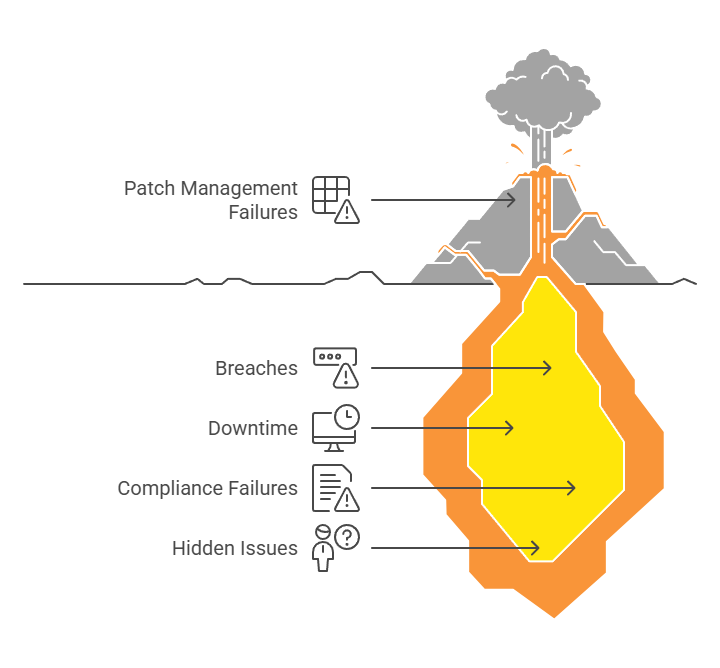
Here’s what often gets overlooked:
1. Incomplete Asset Visibility
You can’t patch what you can’t see. Shadow IT, unmanaged devices, and untracked third-party apps often fly under the radar. These become blind spots that no patching tool can catch on its own.
2. Poor Coordination Between IT and Security
Vulnerability scanners flag critical risks, but patching teams may not act fast enough, or even get the alert. Without a tight process for prioritization and follow-through, high-risk vulnerabilities stay exposed.
3. Misconfigured Automation
Automation without control can backfire. One faulty policy or premature rollout can cause outages, break business apps, or leave endpoints stuck in an unpatched state.
4. Missing Rollback or Testing Workflows
Not all tools support safe pilot rings or staged rollouts. Without testing patches first, or having rollback mechanisms, organizations risk pushing faulty updates at scale.
5. Compliance is Still a Manual Nightmare
Enterprises often struggle to produce clean, audit-ready patching reports, especially when managing multiple tools or platforms. Patch success ≠ compliance without the right evidence.
Related Resource: Want to go beyond the basics and proactively reduce your enterprise risk? Explore the top 10 attack surface management use cases ebook to uncover blind spots, eliminate shadow IT, and stop ransomware before patching even begins.

Moreover, these aren’t tool problems.
They’re strategy and integration problems. That’s exactly where cybersecurity experts like Datacipher come in.
How Datacipher Helps You Get Patch Management Right?
At Datacipher, we don’t just implement tools. We help enterprises build a resilient, fully managed patching strategy that aligns with their IT infrastructure, business goals, and compliance standards.
Whether you use Microsoft Intune, BigFix, Tanium, Qualys, Automox, or a mix of platforms, our NOC-driven patch management services ensure that no endpoint or device gets left behind.

Source – Datacipher
Here’s what we bring to the table:
#1. Complete Endpoint Visibility and Hygiene
From workstations to edge devices, we help you maintain asset inventory and system health, so no critical endpoint goes unpatched or unmanaged.
#2. Real-Time Patch Monitoring and Enforcement
We schedule and deploy patch cycles, monitor compliance, and remediate failures, all as part of 24/7 NOC services tailored to your environment.
#3. Security and Risk Alignment
We bridge the gap between vulnerability scanning and patch enforcement, ensuring your patching program reduces real-world exploitability, not just compliance risk.
#4. Integrated Server, Network, and Backup Monitoring
Our NOC teams manage server uptime, network availability, and backup integrity. This gives enterprises one cohesive view across IT and security operations.
#5. Multi-Platform Support with Tool Agnosticism
We support all major RMM, patching, and endpoint tools, and design workflows that integrate seamlessly with your tech stack (ServiceNow, Defender, Splunk, etc.).
#6. Compliance Reporting and Audit Readiness
We generate and maintain audit-ready logs and compliance dashboards for all major standards including PCI DSS, ISO 27001, HIPAA, and more.
#7. Flexible Service Model
Our a la carte model means you only pay for what you need. This means you can scale services without inflating overhead.
These outcomes aren’t theoretical. For instance, here’s how one enterprise transformed their patch operations. A regional banking group was facing audit pressure due to inconsistent patch compliance across 18,000 endpoints. We implemented automation workflows, tested deployment rings, and built dashboards aligned with regulatory needs. Within six weeks, patch success rates rose by 89%, and our client cleared its next audit with zero remediation findings.
Are you ready to strengthen your patch management without adding IT overhead? Let Datacipher’s 24/7 NOC-backed security team help you eliminate patching blind spots, reduce exposure, and maintain compliance. Irrespective of the tools you use.
Book a consultation today and see how our patch management experts can keep your systems secure, your audits clean, and your IT team stress-free.
Frequently Asked Questions
1. What’s the risk of relying only on automation for patch deployment?
If automation is misconfigured or applied without proper testing, it can cause more harm than good. A bad patch can bring down critical systems. The risk isn’t automation itself. It’s skipping validation steps like pilot rings, rollback testing, or staged rollouts.
2. How often should enterprise systems be patched to stay secure and compliant?
It depends on the severity of the vulnerability. High-risk patches should be applied within 24–72 hours. Lower-risk updates can follow monthly cycles. Most compliance frameworks expect patching within 30 days. What matters is consistency, prioritization, and proof that patching is being done.
3. What if my patch management tool doesn’t cover third-party apps?
That’s a real risk. Third-party software like browsers, remote tools, or media players are often targeted by attackers. If your tool doesn’t support them, you’ll need to either supplement with a second solution or switch to one that offers broader coverage.
4. Do I need a separate solution for compliance reporting?
Not always. Some patch tools include reporting, but they vary in depth. What matters is whether you can generate audit-ready logs by system, user, and patch status, without manual work. If your current tool can’t do that, you might need an additional reporting layer.
5. Can Datacipher integrate patching with our vulnerability management workflow?
Yes. We connect vulnerability findings with patch deployment pipelines, so CVEs aren’t just flagged, they’re fixed. This means aligning your scanners, patch tools, and ticketing systems for faster resolution and better risk visibility across teams.
6. Is patch management included in Datacipher’s NOC services, or is it separate?
It’s included. Patch management is one of the core services in most NOC packages, covering patch scheduling, monitoring, and failure remediation — typically alongside server and workstation management.

